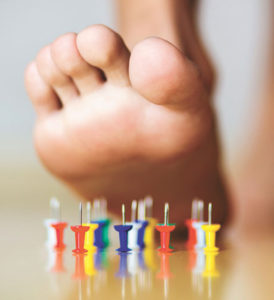 Roughly, 29 million Americans have diabetes. Many of these cases are undiagnosed, but for those individuals that struggle with the disease, symptoms of diabetic neuropathy can be debilitating.
Roughly, 29 million Americans have diabetes. Many of these cases are undiagnosed, but for those individuals that struggle with the disease, symptoms of diabetic neuropathy can be debilitating.
Diabetic neuropathy is a progressive disease that affects nearly 200,000 new patients per year. Understanding the disease state is complex, but in short, having high blood sugar levels, along with low blood and oxygen supply, damages the nerves throughout the body. This damage generally affects the long peripheral nerves that feed sensations to the legs, feet, and toes from the spinal cord, through communication with the brain. If your condition has progressed, you may feel nerve damage sensations in your upper extremities as well.
Peripheral Neuropathy Symptoms
• Numbness
• Tingling
• Burning sensations
• Painful aching
• Joint inflammation
• Joint damage
• Balance issues
• Skin discoloration & texture changes
• Muscle cramps
• Feelings of stiffness
• Non-healing foot & ankle ulcers
Once the peripheral nerves are damaged, there is no cure. Along with medications and drug therapies, there are proven methods to lessen the symptoms of peripheral diabetic neuropathy. Physical medicine provides alternative therapeutic and rehabilitating procedures that can offer significant pain relief and limit drug dependency. Physical therapy helps with balance and can reduce the risk of falls.
When you have diabetic neuropathy, your feet and legs can feel so numb that you may trip, fall and injure yourself just by trying to get through normal daily activities. This can be dangerous for obvious reasons. Along with dietary changes, orthopedic shoes and compression stockings, physical therapy can help.
Physical & Occupational Therapy Benefits
• Manual stretching
• Hip & Ankle Alignment Strategies
• Decompression
• Massage therapy
• Electrical nerve stimulation
• Help with daily tasks & Living
• Cold laser treatment
Patient & Occupational Education is critical to alleviate further injury and to promote the most efficacious healing. Coupled with family participation, self-help management to promote and maintain independent function, and mobility is critical.
Physical therapy is used to help with numerous indications and conditions like retraining the body to improve gait and balance and also after hip, knee or shoulder replacement and so much more. There is no better way to alleviate pain, increase range-of-motion and live a more mobile higher quality of life than through physical & Occupational therapy.
To find out more or to schedule your appointment, please contact Innovative Therapies Group today.
Innovative Therapies Group, Inc.
352-433-0091 | innovativetherapiesgroup.com
 Central Florida Health and Wellness Magazine Health and Wellness Articles of the Villages
Central Florida Health and Wellness Magazine Health and Wellness Articles of the Villages



